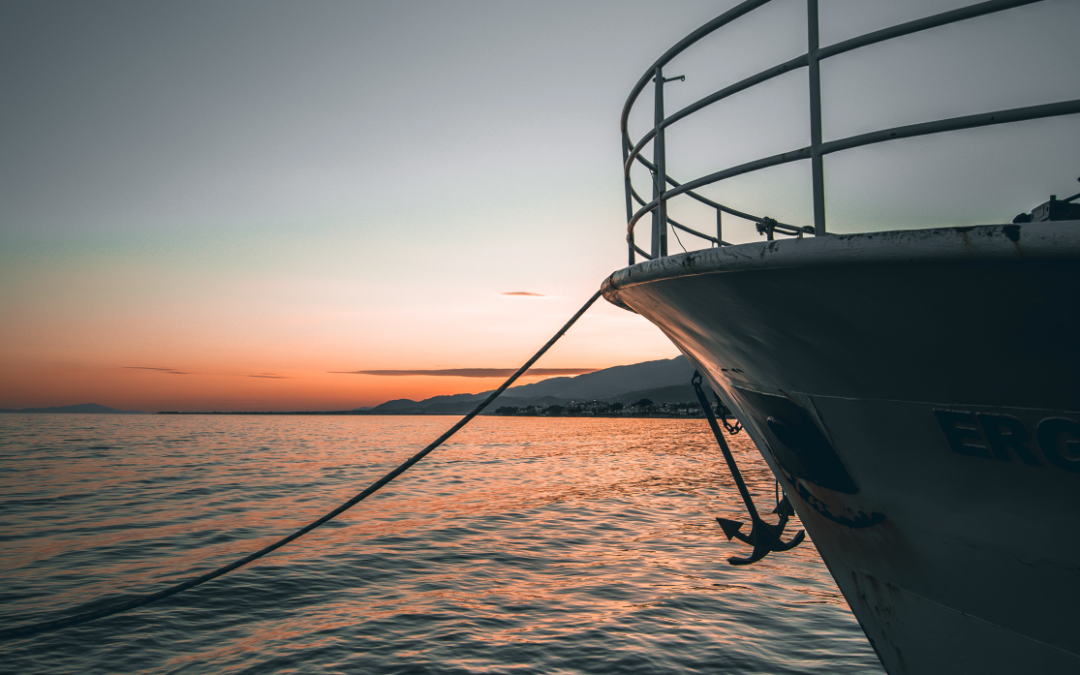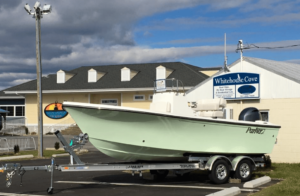Importance of selecting the right anchor for boaters’ safety and peace of mind.
The safety and peace of mind of boaters largely depend on selecting the right anchor for their vessels. Anchors play a crucial role in securing boats in various conditions, be it during calm waters or rough seas. A well-suited anchor provides stability, prevents drifting, and ensures the boat remains in place, giving boaters the confidence to relax and enjoy their time on the water.
Choosing the wrong anchor, on the other hand, can lead to unwanted drifting, endangering both the boat and its passengers. Thus, understanding how to select the right anchor becomes essential knowledge for every boater, empowering them to make informed decisions and navigate with confidence.
Ready to reserve a boat slip on the Chesapeake Bay? Contact Whitehouse Cove Marina in Poquoson Today! Call 757-231-1006 or request a reservation online here.
The convenience of finding the perfect anchor while at a marina in Poquoson.
At the marina in Poquoson, boaters have the convenience of finding the perfect anchor for their boats. Marina facilities often offer a variety of anchor types and sizes to cater to different boat specifications and varying sea conditions. Boaters can seek guidance from knowledgeable marina staff who understand the local waters and can provide valuable insights into which anchor type suits their specific needs best. With easy access to a diverse selection of anchors, boaters at the Poquoson marina can equip themselves with the right tools for anchoring, enhancing the safety and enjoyment of their boating experiences.
The importance of proper anchoring for boat slip rentals and transient dockage
Proper anchoring is not only crucial for the safety of individual boaters but also for the smooth functioning of boat slip rentals and transient dockage at the marina. Boaters who dock at the marina in Poquoson rely on secure and reliable anchoring systems to ensure their vessels remain stable and protected while they explore the scenic surroundings or take a break from their maritime journeys.
A well-anchored boat enhances the overall boating experience, allowing boaters to return to their vessels with peace of mind, knowing their boats are safely moored. For transient boaters who seek temporary dockage during their travels, understanding anchoring techniques becomes even more critical, as they may encounter diverse sea conditions in unfamiliar territories. Proper anchoring practices at the marina contribute to a harmonious boating community, ensuring that every boater enjoys a worry-free and pleasant stay.
Understanding Anchor Types and Their Applications
The different types of anchors available for boats, such as fluke, claw, plow, and mushroom anchors
Boaters have various anchor types to choose from, each designed to serve different purposes and excel in specific conditions. Fluke anchors, also known as Danforth anchors, are popular for their lightweight and foldable design, making them easy to store. Claw anchors, resembling a claw-like shape, are renowned for their efficiency in rocky seabeds.
Plow anchors, with their sharp, curved flukes, offer excellent holding power in sandy and muddy bottoms. Mushroom anchors, characterized by their round, weighted shape, are ideal for soft and weedy seabeds. Understanding the differences between these anchor types is essential for boaters to select the one that best suits their boating needs.
The applications and suitability of each anchor type based on the boat’s size, weight, and sea conditions
The applications and suitability of anchor types largely depend on the boat’s size, weight, and sea conditions. Fluke anchors are particularly suitable for small to medium-sized boats and are effective in sandy and muddy bottoms. Their lightweight nature makes them easy to handle, making them a top choice for recreational boaters. Claw anchors, on the other hand, are renowned for their versatility and performance in rocky seabeds, making them ideal for boaters exploring coastal areas with such conditions.
Plow anchors are preferred for their holding power and work well with larger boats, offering reliable anchoring in sandy and muddy bottoms. For boaters seeking stability in soft and weedy seabeds, mushroom anchors prove to be effective, especially for smaller vessels.
How different anchor types perform in various seabeds, including sand, mud, and rocky bottoms.
The performance of different anchor types in various seabeds is a crucial consideration for boaters to achieve a secure hold. Fluke anchors excel in sandy and muddy bottoms, where their flukes can dig into the loose sediment and hold the boat in place. Claw anchors’ unique design allows them to grasp onto rocky surfaces, providing stability in rocky seabeds where other anchors may struggle.
Plow anchors perform exceptionally well in sand and mud due to their curved shape, which allows them to penetrate and hold in these soft seabeds effectively. Mushroom anchors are specifically designed for soft and weedy bottoms, as their weighted round shape enables them to sink and create a reliable hold in such conditions. Understanding how different anchor types interact with various seabeds empowers boaters to select the most suitable anchor for their specific boating environments, enhancing the safety and peace of mind during anchoring activities.
Factors to Consider When Choosing an Anchor
Boat Size and Weight: How to match the anchor size and weight to your boat’s specifications
One of the key factors to consider when selecting an anchor is matching its size and weight to your boat’s specifications. Larger and heavier boats require anchors with greater holding power to secure them properly. An anchor that is too small for your boat may not be able to hold it in place during adverse weather conditions or strong tidal currents. On the other hand, an anchor that is too large and heavy may be challenging to handle and store on your boat. To determine the appropriate anchor size and weight, consult the anchor manufacturer’s guidelines or seek advice from experienced boaters or the staff at the marina in Poquoson. They can assist you in selecting an anchor that perfectly aligns with your boat’s specifications, ensuring a safe and reliable anchoring experience.
Holding Power: The importance of anchor holding power in different weather conditions and tidal currents
The holding power of an anchor is of utmost importance when it comes to anchoring your boat in different weather conditions and tidal currents. Holding power refers to the anchor’s ability to maintain its position and prevent the boat from drifting. Anchors with higher holding power provide better stability and security for your vessel, even in challenging conditions such as strong winds or swift currents. When evaluating an anchor’s holding power, consider factors such as the anchor type, its design, and the seabed conditions where you plan to anchor. Anchors with flukes or plows tend to offer superior holding power compared to mushroom anchors in many situations. Prioritizing the holding power of the anchor ensures that your boat remains secure and reduces the risk of drifting or dragging during your boating adventures.
Bottom Conditions: How to assess the seabed type and select an anchor accordingly for reliable anchoring.
Assessing the seabed type is essential in selecting the right anchor for reliable anchoring. Different anchor types perform optimally in various bottom conditions, such as sand, mud, or rocky surfaces. Understanding the composition of the seabed where you plan to anchor helps you choose an anchor that can effectively penetrate and grip the bottom, providing a secure hold. If you’re unsure about the seabed conditions, consult nautical charts or local boating guides, which often provide valuable information about the types of seabeds prevalent in the area.
Moreover, talking to experienced boaters at the marina in Poquoson can offer firsthand insights into the seabed conditions commonly encountered in the region. By matching your anchor type to the bottom conditions, you enhance the effectiveness of anchoring and ensure a worry-free boating experience, free from the concern of drifting or dragging.
Anchor Materials and Construction
Materials used in anchor construction: galvanized steel, stainless steel, and aluminum
When considering anchor materials, boaters will encounter various options, each offering unique attributes that cater to specific needs. Galvanized steel anchors are a popular choice for their affordability and durability. These anchors are coated with a layer of zinc, providing excellent corrosion resistance and protecting them from rust and degradation in marine environments. Stainless steel anchors, on the other hand, are renowned for their superior corrosion resistance, making them ideal for boaters navigating saltwater or brackish conditions.
While stainless steel anchors tend to be more expensive than galvanized ones, their longevity and resistance to rust make them a worthwhile investment. Aluminum anchors are a lightweight option favored by smaller boat owners or those who prioritize easy handling and storage. Although aluminum anchors may not be as durable as steel options, they are an excellent choice for boaters seeking a lightweight and portable anchoring solution.
The benefits and considerations of each material, including corrosion resistance and weight
Each anchor material comes with its benefits and considerations. Galvanized steel anchors strike a balance between affordability and durability, making them a popular choice for a wide range of boaters. The zinc coating provides robust corrosion resistance, extending the anchor’s lifespan and ensuring reliable performance. However, over time, the zinc layer may wear down, requiring periodic inspections and maintenance. Stainless steel anchors boast exceptional corrosion resistance, making them ideal for long-term use in saltwater environments.
They are generally heavier and more expensive than galvanized options, but their resistance to rust makes them a wise investment for boaters seeking durability and longevity. Aluminum anchors are favored for their lightweight nature, making them easy to handle and ideal for smaller vessels. Their portability and corrosion resistance in fresh and saltwater conditions make them a practical choice for day boaters or those exploring shallow waters. However, boaters should exercise caution when using aluminum anchors in rocky or abrasive seabeds, as the material may be susceptible to wear and damage over time.
Advanced anchor features: swivels and roll bars for improved performance
Advanced anchor features can further enhance performance and ease of use. Swivels, for example, are a valuable addition that prevents anchor chains from tangling, allowing the anchor to set effectively and maintain its hold. Swivels reduce the risk of anchor rotation and provide a more secure anchoring experience. Roll bars are another beneficial feature, especially for plow anchors. They ensure the anchor aligns correctly upon retrieval, reducing the chances of snagging or getting stuck in the seabed.
Some anchors feature adjustable fluke angles, allowing boaters to modify the angle based on the seabed conditions they encounter. Boaters can also opt for folding or collapsible anchor designs, ideal for easy storage and handling on smaller vessels. Understanding these advanced features empowers boaters to select an anchor that aligns with their specific needs and enhances the effectiveness of anchoring in diverse conditions.
Anchor Accessories and Safety Measures
Anchor Rodes and Chains: The significance of properly selecting the right rode and chain length
Anchor Rodes and Chains: Selecting the right anchor rode and chain length is crucial for ensuring a secure and reliable anchoring experience. The anchor rode refers to the combination of rope or line and chain that connects the anchor to the boat. When choosing a rope, look for high-quality materials with strong tensile strength to withstand the forces exerted during anchoring. Nylon ropes are a popular choice due to their elasticity, which absorbs shock loads and reduces stress on the boat and anchor. It is essential to determine the appropriate length of the anchor rode, which should be at least seven to ten times the depth of the water in calm conditions and even longer in rough seas.
Incorporating a chain in the anchor rode provides added weight and reduces the risk of the anchor dragging. The chain also aids in maintaining the anchor’s position and enhances its holding power. Properly selecting the right anchor rode and chain length ensures a secure hold and minimizes the risk of drifting or dragging, giving boaters peace of mind during their anchoring activities.
Anchor Markings and Buoy Systems: Tips for marking anchors and deploying buoy systems for easy retrieval
Anchor Markings and Buoy Systems: Effectively marking anchors and deploying buoy systems facilitate easy retrieval and add an extra layer of safety to the anchoring process. When anchoring in unfamiliar or crowded waters, attaching a buoy to the anchor line makes it easily visible, alerting other boaters to the anchor’s presence and reducing the chances of tangling with other vessels’ lines. Buoy systems also simplify the process of locating and retrieving the anchor when it is time to leave.
In addition to buoy systems, boaters can use anchor markings to identify the type and size of the anchor and its compatibility with specific seabeds. Painting or taping the anchor’s shank with color-coded markings helps boaters quickly distinguish between different anchor types in their collection. Properly marking anchors and deploying buoy systems not only aids in the efficient retrieval of the anchor but also contributes to a safe and organized anchoring experience for all boaters.
Safety Considerations: Proper anchoring techniques to avoid accidents and ensure safe boating experiences
Safety Considerations: Practicing proper anchoring techniques is essential to avoid accidents and ensure safe boating experiences. Boaters should never compromise on safety measures, such as wearing appropriate personal flotation devices (PFDs) while handling anchors. When dropping or retrieving anchors, it is crucial to maintain a safe distance from the anchor line and avoid getting entangled or pulled overboard. Always ensure that bystanders are clear of the anchor’s swing zone to prevent injuries or collisions. Before anchoring, boaters should assess the surrounding environment, considering factors such as water depth, tide changes, and proximity to other vessels or obstacles.
Adequate scope— the ratio of anchor rode length to the water depth— is essential for proper anchoring. Avoid short scope as it reduces the anchor’s holding power, increasing the risk of dragging. It is also essential to periodically inspect the anchor, rode, and chain for signs of wear, corrosion, or damage, and replace any compromised components promptly. By adhering to these safety considerations and best practices, boaters can anchor with confidence, knowing they are prioritizing their safety and that of others on the water.
Anchoring Techniques and Best Practices
Step-by-step guide on how to set and retrieve anchors effectively
Anchoring is a precise process that requires careful execution to ensure a secure hold. To set the anchor effectively, position the boat into the wind or current and slowly lower the anchor overboard, allowing the anchor to settle gently on the seabed. Once the anchor touches the bottom, let out the anchor rode while keeping the boat in reverse to set the anchor firmly. Gradually increase the throttle in reverse until the boat comes to a halt, indicating the anchor has set. Next, back down gently to test the anchor’s hold and ensure it grips the seabed securely.
When it’s time to retrieve the anchor, slowly motor towards the anchor while pulling in the anchor rode. Once directly above the anchor, gradually reduce the throttle while using the boat’s momentum to dislodge the anchor from the seabed. Continue pulling in the anchor rode as the boat moves forward, ensuring a smooth retrieval process.
Tips for preventing anchor dragging and repositioning the anchor if needed
To prevent anchor dragging, it is essential to choose an appropriate anchoring spot based on the seabed conditions and the expected weather changes. Avoid anchoring in areas with strong currents, rocky bottoms, or thick seaweed, as these can reduce the anchor’s holding power. In adverse weather conditions, such as high winds or rapid tide changes, increase the scope to enhance the anchor’s grip on the seabed. Regularly monitor the anchor’s position using reference points on the shore or GPS devices to detect any potential dragging early.
If the anchor does start to drag, remain calm and reposition the anchor by motoring back to the original anchoring spot and setting the anchor again using the step-by-step guide mentioned above. Alternatively, if there is insufficient room to re-anchor, carefully raise the anchor, and look for a safer spot to set it again.
Explain the importance of regular anchor maintenance and inspection
Explain the importance of regular anchor maintenance and inspections: Regular anchor maintenance and inspections are crucial for preserving the anchor’s performance and longevity. After each use, rinse the anchor, rode, and chain with fresh water to remove salt and debris that could cause corrosion. Thoroughly dry the components before storage to prevent mold or rust. Regularly inspect the anchor, focusing on the flukes, shank, and chain for signs of wear, cracks, or damage. Replace any worn or compromised parts promptly to ensure the anchor’s reliability.
Additionally, inspect the anchor rode and buoy systems for wear and tear, replacing any worn-out sections. Store the anchor in a dry, well-ventilated area when not in use to prevent corrosion and extend its lifespan. By prioritizing regular maintenance and inspections, boaters can count on their anchor to perform optimally when needed, ensuring a safe and successful anchoring experience during their boating adventures.
That’s a wrap: how to choose the best anchor for boating on the Chesapeake Bay
Recap: the importance of selecting the right anchor for safety and peace of mind
As we conclude this comprehensive guide on selecting the right anchor for your boat, it is essential to emphasize the critical role anchors play in ensuring boaters’ safety and peace of mind. Anchors are not mere accessories; they are vital tools that provide stability, security, and control while navigating the waters. Choosing the right anchor that aligns with your boat’s specifications and the prevailing sea conditions empowers you to anchor with confidence, knowing your vessel is secure and protected.
Whether you’re exploring the serene waters of Poquoson or venturing out to Norfolk or Virginia Beach marinas, a reliable anchor will be your steadfast companion, allowing you to savor every moment of your boating adventures without worry.
Make informed anchor choices for boat slip rentals and transient dockage stays, ensuring an enjoyable and worry-free boating experience
As you embark on your boating adventures, we encourage you to make informed anchor choices, taking into account your boat’s specifications, the prevailing conditions, and the advice of experienced boaters and marina professionals. Properly anchoring your boat during your boat slip rentals or transient dockage at our marina enhances your overall boating experience, allowing you to fully immerse yourself in the joy and freedom of the water.
Selecting the right anchor is an investment in your boating safety and the preservation of our precious marine environment. As responsible stewards of the sea, we urge you to prioritize responsible anchoring practices to protect our waterways and ensure that future generations can enjoy the wonders of boating just as we do today. So, set sail with confidence, and let the perfect anchor be your guide to memorable and fulfilling boating experiences.
Reserve your summer boat slip at Whitehouse Cove Marina on the Chesapeake Bay! Call 757-231-1006 or request a reservation online here.



